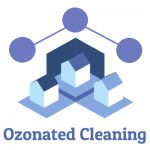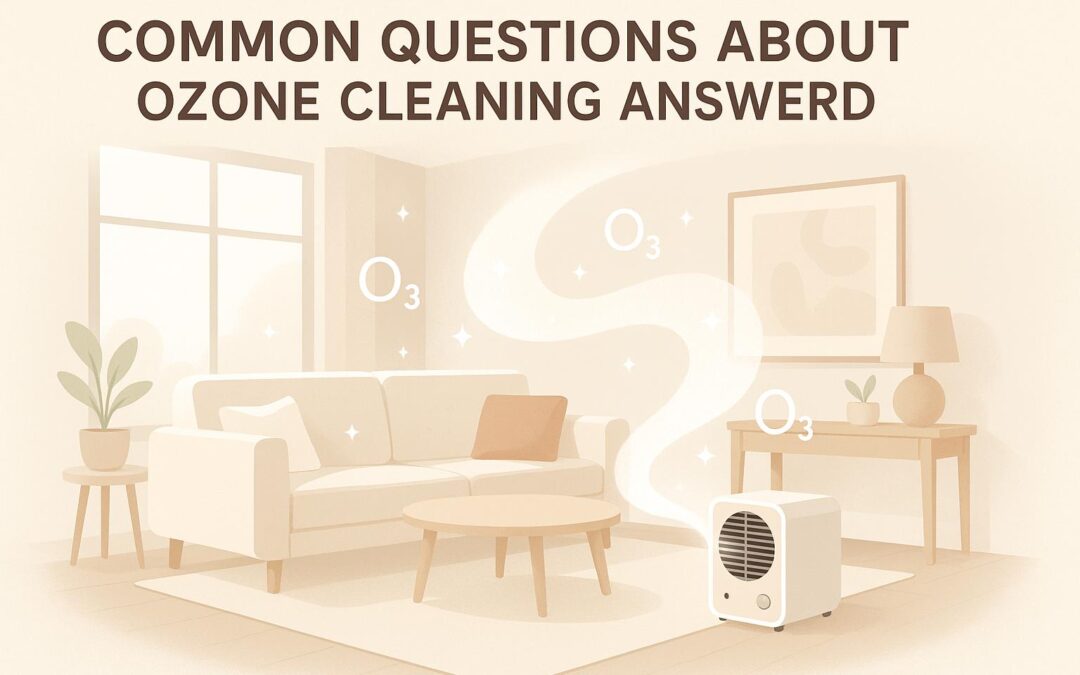Ozone cleaning is a powerful way to sanitize spaces, eliminate odors, and kill bacteria or viruses. It uses ozone (O₃), a molecule made of three oxygen atoms, to oxidize and neutralize contaminants. The best part? Ozone reverts to regular oxygen after treatment, leaving no harmful residue behind. Here’s a quick overview:
- How It Works: Ozone breaks down bacteria, viruses, and odors by oxidizing them.
- Where It’s Used: Homes, hotels, vehicles, medical facilities, and water systems.
- Safety First: Spaces must be empty during treatment, and ventilation is required afterward.
- Effectiveness: Removes up to 97% of bacteria and viruses and works 50x faster than chlorine.
Quick Comparison: Ozone Cleaning Benefits vs. Limitations
| Benefits | Limitations |
|---|---|
| No chemical residue left behind | Requires evacuation during treatment |
| Removes odors and kills pathogens | Equipment can be expensive upfront |
| Faster and more effective than chlorine | Not suitable for occupied spaces |
| Approved by EPA, FDA, USDA, and OSHA | Needs proper monitoring for safety |
Whether you’re tackling stubborn odors or sanitizing large areas, ozone cleaning offers a chemical-free, efficient solution when used correctly. Always follow safety protocols for the best results.
Sanitize Everything With Ozone
Ozone Cleaning Basics
This section breaks down the science and process of ozone cleaning, focusing on how oxidation works to neutralize contaminants.
How Ozone Molecules Work
Ozone (O₃) consists of three oxygen atoms, making it a powerful oxidizer. When an ozone molecule comes into contact with bacteria, viruses, or odor-causing compounds, its extra oxygen atom detaches, oxidizing and neutralizing them. Afterward, ozone naturally reverts to regular oxygen, leaving no residue.
In water treatment, ozone eliminates bacteria 3,125 times faster than chlorine.
Step-by-Step Treatment Process
Here’s how the ozone cleaning process works:
- Pre-Treatment Preparation
Start by cleaning the area to remove surface dirt and debris. - Environment Setup
Ensure the space is clear of people, pets, and plants. Keep the area dry, as ozone is more effective in low-humidity conditions. - Treatment Application
Place ozone generators in strategic locations. Treatment durations vary based on the area size, ranging from 20 minutes for small spaces to 2.5 hours for larger ones. Key factors influencing treatment time include:
Factor Impact on Treatment Room Size Larger spaces require longer treatments Ceiling Height Higher ceilings demand more ozone Air Tightness Sealed spaces retain ozone better Contamination Level Heavily contaminated areas need extended treatment - Post-Treatment Protocol
After treatment, allow the area to ventilate until the ozone converts back to oxygen. Avoid occupying the space during this airing-out period.
Under the right conditions, ozone cleaning can eliminate up to 97% of bacteria and viruses. It’s widely used for sterilizing medical instruments and treating water systems.
Next, we’ll explore how ozone cleaning performs across different applications.
Results and Performance
Germ and Bacteria Removal
The World Health Organization states that ozone treatment, when applied correctly, can eliminate 97% of bacteria, viruses, and mold. At ozone levels above 7 ppm, it disrupts pathogens by cutting off their oxygen supply.
| Surface Type | Effectiveness |
|---|---|
| High-Touch Areas | Reaches spots that regular cleaners can’t access |
| Air Space | Cleans both surfaces and airborne contaminants |
| Porous Materials | Penetrates deep into fabrics and other materials |
| Water Systems | Removes bacteria present in water |
Let’s look at how ozone cleaning handles tough odors next.
Types of Odors Eliminated
Ozone cleaning doesn’t just cover up odors – it changes the chemical structure of the molecules causing them.
"It’s what takes away that smell. The other things are just helping. If you don’t do ozone, you still have the smell underneath the paint." – Mike Calamus, Owner of Calamus Enterprises
Here are some odors ozone cleaning can handle:
- Smoke and cigarette smells
- Pet-related odors
- Food and cooking smells
- Mold and mildew
- Marijuana
- General musty environments
This ability to address a wide range of odors makes ozone cleaning useful in many scenarios.
Where to Use Ozone Cleaning
Ozone cleaning is especially helpful in areas where traditional cleaning methods fall short.
| Setting | Primary Uses |
|---|---|
| Residential | Fire damage cleanup, mold removal, deodorizing |
| Commercial | Refreshing hotel rooms, sanitizing offices |
| Vehicles | Removing odors in cars, RVs, and boats |
| Medical | Sterilizing instruments, cleaning facilities |
| Water Systems | Treating pools/spas, purifying drinking water |
sbb-itb-5fea4da
Safety Guidelines
During Treatment Safety Rules
The area being treated must stay completely empty during the process. This means no people, pets, or plants should be present. Remove items that could be damaged, such as artwork, rubber materials, or other sensitive objects. Place clear "NO ENTRY" signs at all entrances, and always rely on the ozone generator’s built-in timer for safe operation.
Exposure to ozone gas can lead to serious health issues, including lung damage, chest pain, coughing, shortness of breath, and throat irritation. Following these precautions is critical for safety.
Air-Out Requirements
Proper ventilation after treatment is essential to remove any leftover ozone before reentering the space. The time needed depends on the ventilation setup:
| Ventilation Type | Required Time | Method |
|---|---|---|
| Windows Available | 30 minutes | Open all windows and doors |
| No Windows | Up to 4 hours | Use the HVAC system |
| Basement Areas | 2–3 hours | Run air conditioning and ventilate through doors |
Safety Standards
Strict safety protocols are in place for ozone cleaning to ensure safe and effective use. Here are the key guidelines:
- Monitoring and Training: Always use ozone monitors to confirm safe levels before reentry. Operators must be trained and certified to handle ozone equipment safely.
- Treatment Duration: Keep exposure time limited to reduce the risk of material damage during treatment.
Ozone naturally breaks down with a half-life of about 15 minutes, quickly converting back into oxygen. If you’re considering continuous disinfection systems for occupied spaces, consult an ozone expert first. Ozone is known to be 50 times more effective at disinfection than chlorine.
Pros and Cons
Ozone cleaning comes with both benefits and challenges:
Side-by-Side Comparison
| Advantages | Limitations |
|---|---|
| 50 times more effective than chlorine for disinfection | Higher upfront equipment costs |
| Neutralizes odors by breaking down odor-causing compounds | Requires evacuation during treatment |
| Breaks down into pure oxygen, leaving no chemical residue | 2–3 hour wait time before reentry |
| On-site generation eliminates chemical storage needs | Needs ozone monitoring for safety |
| Quickly eliminates pathogens | Unsuitable for spaces with continuous occupancy |
| Approved by EPA, FDA, USDA, and OSHA |
These points highlight ozone cleaning’s effectiveness while also pointing out its practical limitations.
Experts in the field emphasize its advantages:
"Unlike chlorine, ozone leaves no harmful chlorinated by-products in the water, ozone quickly reverts back to pure oxygen if unused"
"The ozone generator will transform a foul-smelling substance into a non-odorous substance by destroying the airborne cells that produce the odor, all without the use of harmful chemicals."
Research backs these claims, showing that "Ozone oxidation reactions take place several thousand times faster than those of chlorine for destruction of bacteria, viruses, yeast, molds, cysts, mildew, and most other organic and inorganic contaminants".
Despite its efficiency, ozone cleaning requires careful monitoring, precise timing, and strict safety protocols. While the initial costs for equipment and training are higher than traditional methods, ongoing operational expenses are often reduced over time.
Knowing these benefits and drawbacks underscores the need to follow safety guidelines and treatment protocols closely.
Conclusion
Research confirms that ozone eliminates bacteria much faster than older methods, making it a highly effective option for sanitization. Its proven ability to disinfect extends to areas like water purification, air cleaning, and odor removal, with strong scientific support backing these claims.
Ozone is a natural choice because it breaks down into pure oxygen, leaving no harmful chemical residues behind. This process ensures that treated areas remain free from potentially dangerous by-products.
Since 2007, Ozonated Cleaning LLC has been offering professional ozone cleaning services across Northern Illinois, Southern Wisconsin, and Northwest Indiana. Their certified technicians use high-concentration ozone shock treatments alongside antimicrobial biostatic surface protection to achieve thorough sanitization and long-lasting results.
For the best outcomes, proper application of ozone is key. Professional services follow strict safety protocols and ensure proper ventilation, delivering a safe, chemical-free cleaning solution that provides superior sanitization and durable protection.
FAQs
What safety steps should I follow before and after using ozone cleaning at home?
Before using an ozone generator, make sure to remove all people, pets, and plants from the room. Close all windows and doors, and set a timer to allow the generator to run safely while the space is unoccupied. It’s important to leave the area entirely while the ozone machine is in operation.
After the treatment is complete, ventilate the space thoroughly. Open windows and doors to let fresh air circulate for at least 30 minutes. If the ozone was used in a basement or poorly ventilated area, consider using air conditioning or fans to help clear the air more efficiently. These steps ensure the space is safe to re-enter and free from residual ozone.
How does ozone cleaning compare to other sanitization methods in terms of cost and effectiveness?
Ozone cleaning stands out as a highly effective and cost-efficient sanitization method over time. While the upfront cost of an ozone system may be higher than chemical disinfectants like chlorine, it eliminates ongoing expenses such as purchasing, transporting, and storing chemicals, as well as the need for personal protective equipment (PPE). Over the long term, this can lead to significant savings.
In terms of effectiveness, ozone is 50 times more powerful and works 3,000 times faster than chlorine when it comes to eliminating bacteria, viruses, and other harmful contaminants. Many users find that ozone systems can pay for themselves within 12 to 24 months, making them a smart investment for both residential and commercial applications.
Is ozone cleaning safe to use in busy spaces like offices or schools while people are present?
No, ozone cleaning is not safe for use in spaces that are occupied, such as offices or schools. High levels of ozone can be harmful to people and pets, as it can irritate the lungs and respiratory system. For this reason, ozone cleaning should only be performed in unoccupied areas.
To ensure safety, trained professionals should handle ozone cleaning, and the space must remain empty during the treatment process. Once the cleaning is complete, the area should be ventilated thoroughly before anyone re-enters.


Recent Comments